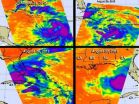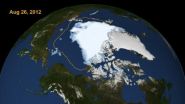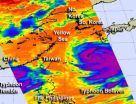(Press-News.org) NASA's Atmospheric Infrared Sounder or AIRS instrument is an infrared "eye" that flies onboard NASA's Aqua satellite. AIRS has been providing the National Hurricane Center with valuable temperature data on Isaac's clouds and the surrounding sea surface temperatures, and a time series of data shows that Isaac is consolidating.
The AIRS instrument has been monitoring Tropical Storm Isaac for several days. AIRS data from Aug. 24, 25, 26 and 27 showed Isaac's movements through the eastern and central Caribbean Sea, across eastern Cuba and into the Gulf of Mexico. On Aug. 24, Isaac's strongest convection (rising air that forms the thunderstorms that make up a tropical cyclone) appeared all around the center, except in the western quadrant of the storm. On Aug. 25, when Isaac was affecting Haiti, it appeared more disorganized, and the strongest storms extended from southwestern Haiti into the central Caribbean Sea. On Aug. 26, AIRS data showed the area of strong convection had increased and the largest area was over the Florida Keys, with bands of strong thunderstorms extending over southeastern Florida and the Bahamas. On Aug. 27, Isaac's center of circulation appeared more rounded on AIRS imagery, indicating the circulation center was becoming more organized.
Southeasterly wind shear and the larger than average wind radii, and entrance of some dry air had been keeping Isaac from strengthening more quickly today, Aug. 27. That wind shear is the result of an upper-level low pressure area that lies southwest of Tropical Storm Isaac. As that low moves away and the wind shear lessens, Isaac will have more ability to strengthen.
Where is Isaac on Aug. 27?
At 11 a.m. EDT (1200 UTC) on Monday, Aug. 27, Isaac was a strong tropical storm with maximum sustained winds near 65 mph (100 kmh). Isaac is expected to become a hurricane in the next day or two over the warm waters of the Gulf of Mexico. When Isaac reaches maximum sustained winds of 74 mph, it will be classified as a category one hurricane. Isaac's cloud extent is about 480 miles in diameter, as tropical-storm-force winds extend outward up to 240 miles (390 km) from the center.
VIDEO:
An animation of satellite observations from Aug. 25-27, 2012, shows Tropical Storm Isaac moving past Cuba and the Florida Keys and into the eastern Gulf of Mexico. This visualization was...
Click here for more information.
Tropical Storm Isaac was located about 250 miles (400 km) south of Apalachicola, Fla. and about 310 miles (500 km) southeast of the mouth of the Mississippi River. That puts Isaac's center near latitude 25.7 north and longitude 84.7 west. Isaac is moving toward the west-northwest near 14 mph (22 kmh) and the tropical storm is expected to continue on that track, but slow down before turning to the northwest on Tuesday, Aug. 28. The National Hurricane Center expects Isaac to move over the eastern Gulf of Mexico later today, Aug. 27 and approach the northern Gulf coast in the hurricane warning area on Tuesday, Aug. 28.
Hurricane Warnings and Watches
A Hurricane Warning is in effect from east of Morgan City, Louisiana to Destin, Fla., including metropolitan New Orleans, Lake Pontchartrain and Lake Maurepas. A Hurricane Watch is in effect for Intracoastal City to Morgan City, Louisiana.
Tropical Storm Warnings and Watches
A Tropical Storm Warning is in effect for the Florida Peninsula from Ocean Reef Southward on the east coast and from Tarpon Springs southward on the west coast; the Florida Keys including the Dry Tortugas and Florida Bay; east of Destin, Fla. to the Suwannee River; and Intracoastal City to Morgan City, Louisiana. A Tropical Storm Watch is in effect for east of Sabine Pass to west of Intracoastal City, La.
Heavy rainfall, gusty winds, isolated tornadoes and dangerous surf can be expected along Isaac's path. For updates on local effects, go the National Hurricane Center website (www.nhc.noaa.gov).
INFORMATION:
NASA infrared time series of Tropical Storm Isaac shows consolidation
2012-08-28
ELSE PRESS RELEASES FROM THIS DATE:
Rising cardiovascular incidence after Japanese earthquake 2011
2012-08-28
Munich, Germany – August 27 2012: The Japanese earthquake and tsunami of 11 March 2011, which hit the north-east coast of Japan with a magnitude of 9.0 on the Richter scale, was one of the largest ocean-trench earthquakes ever recorded in Japan. The tsunami caused huge damage, including 15,861 dead and 3018 missing persons, and, as of 6 June 2012, 388,783 destroyed homes.
Following an investigation of the ambulance records made by doctors in the Miyagi prefecture, close to the epicentre of the earthquake and where the damage was greatest, cardiologist Dr Hiroaki Shimokawa ...
Panda preferences influence trees used for scent marking
2012-08-28
As solitary animals, giant pandas have developed a number of ways to communicate those times when they are ready to come into close contact. One means of this communication occurs through scent marking. A recent study by San Diego Zoo Global researchers, collaborating with researchers at the Institute of Zoology, Chinese Academy of Science, indicates that pandas make clear and specific choices about what trees are used for scent marking.
"Variables affecting the selection of scent-marking sites included bark roughnesss, presence of moss on the tree trunk, tree diameter ...
Arctic sea ice shrinks to new low in satellite era
2012-08-28
The extent of the sea ice covering the Arctic Ocean has shrunk. According to scientists from NASA and the NASA-supported National Snow and Ice Data Center (NSIDC) in Boulder, Colo., the amount is the smallest size ever observed in the three decades since consistent satellite observations of the polar cap began.
The extent of Arctic sea ice on Aug. 26, as measured by the Special Sensor Microwave/Imager on the U.S. Defense Meteorological Satellite Program spacecraft and analyzed by NASA and NSIDC scientists, was 1.58 million square miles (4.10 million square kilometers), ...
WSU researcher documents links between nutrients, genes and cancer spread
2012-08-28
PULLMAN, Wash.—More than 40 plant-based compounds can turn on genes that slow the spread of cancer, according to a first-of-its-kind study by a Washington State University researcher.
Gary Meadows, WSU professor and associate dean for graduate education and scholarship in the College of Pharmacy, says he is encouraged by his findings because the spread of cancer is most often what makes the disease fatal. Moreover, says Meadows, diet, nutrients and plant-based chemicals appear to be opening many avenues of attack.
"We're always looking for a magic bullet," he says. "Well, ...
A greener way to fertilize nursery crops
2012-08-28
This press release is available in Spanish.
A U.S. Department of Agriculture (USDA) scientist has found a "green" alternative to a type of fertilizer additive that is believed to contribute to the accumulation of heavy metals in waterways.
Ornamental nursery and floral crops require micronutrients like iron, manganese, copper and zinc. But fertilizers that provide these micronutrients often include synthetically produced compounds that bind with the micronutrients so they are available in the root zone.
The most commonly used compounds, known as chelating agents, ...
George Washington University Computational Biology Director solves 200-year-old oceanic mystery
2012-08-28
WASHINGTON — The origin of Cerataspis monstrosa has been a mystery as deep as the ocean waters it hails from for more than 180 years. For nearly two centuries, researchers have tried to track down the larva that has shown up in the guts of other fish over time but found no adult counterpart. Until now.
George Washington University Biology Professor Keith Crandall cracked the code to the elusive crustacean's DNA this summer. His findings were recently published in the journal "Ecology and Evolution," and his research was funded by the National Science Foundation and the ...
NASA sees Typhoon Bolaven dwarf Typhoon Tembin
2012-08-28
NASA satellites are providing imagery and data on Typhoon Tembin southwest of Taiwan, and Typhoon Bolaven is it barrels northwest through the Yellow Sea. In a stunning image from NASA's Aqua satellite, Bolaven appears twice as large as Tembin.
NASA's Moderate Resolution Imaging Spectroradiometer (MODIS) instrument that flies onboard the Terra satellite captured a remarkable image of Typhoon Tembin being dwarfed by giant Typhoon Bolaven at 0240 UTC on Aug. 27, 2012. The visible image shows that the island of Taiwan appears to be squeezed between the two typhoons, while ...
Plants unpack winter coats when days get shorter
2012-08-28
EAST LANSING, Mich. — Mechanisms that protect plants from freezing are placed in storage during the summer and wisely unpacked when days get shorter.
In the current issue of the Proceedings of the National Academy of Sciences, Michael Thomashow, University Distinguished Professor of molecular genetics, demonstrates how the CBF (C-repeat binding factor) cold response pathway is inactive during warmer months when days are long, and how it's triggered by waning sunlight to prepare plants for freezing temperatures.
The CBF cold response pathway was discovered by Thomashow's ...
Parents and readers beware of stereotypes in young adult literature
2012-08-28
COLUMBIA, Mo. — A newly defined genre of literature, "teen sick-lit," features tear-jerking stories of ill adolescents developing romantic relationships. Although "teen sick-lit" tends to adhere to negative stereotypes of the ill and traditional gender roles, it also explores the taboo realm of sexuality, sickness and youth, says the University of Missouri researcher who named the genre in a recent study. Readers and their parents should be aware of how the presentation of disease and disability in these stories can instill prejudices and enforce societal norms in young ...
Divorced parents in hostile relationships use technology to sabotage communication, MU study finds
2012-08-28
COLUMBIA, Mo. – Separated and divorced couples are increasingly using emails, texting and social media to communicate with their ex-partners about their children. However, when ex-spouses use that technology to withhold or manipulate information, the children are the ones who suffer most, according to a University of Missouri family studies expert. A new study suggests divorce counselors should teach separated parents effective ways to use communication technology in order to maintain healthy environments for their children.
Lawrence Ganong, a professor of human development ...



